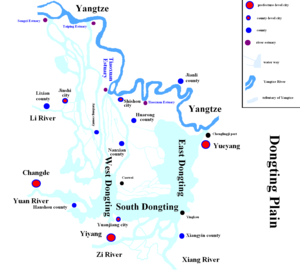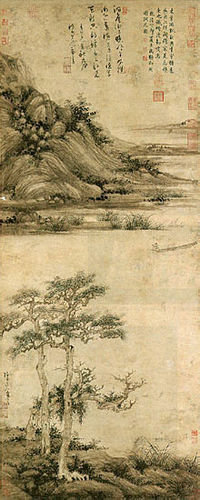Dongting Lake
| Dongting Lake | |
|---|---|
| Tung-tʻing Lake | |
Yangtze | |
| Basin countries | China |
| Surface area | 2,820 km2 (1,090 sq mi) flood season: 20,000 km2 (7,700 sq mi) |
| Official name | Dong-ting hu |
| Designated | 31 March 1992 |
| Reference no. | 551[1] |
| Dongting Lake | ||
|---|---|---|
Tâi-lô | Tōng-tîng Ôo | |

Dongting Lake (
Dongting Lake is famous in Chinese culture as the place of origin of
Geography


In the July–September period, flood water from the
River and Lake
The Dongting Lake catchment area is 257,000 km2 (99,000 sq mi). The lake's only outlet is a natural channel 14 km long and on average 1 km wide. There are four main rivers in the catchment (excluding the area whose water flows directly into the Yangtze River, the same hereafter): the
History
The earliest rice paddies yet discovered in the world were in the Liyang plain, which was then on the western edge of Dongting lake.
At that time, Dongting Lake was China's largest freshwater lake. Because of its size, it gained the name Eight-hundred-li-Dongting (八百里洞庭). Nowadays, it is the second-largest, after Poyang Lake, as much of the lake has been turned into farmland.[8][9]
Culture and mythology

The area is well known in
The scenery of the
Environmental issues
This section needs additional citations for verification. (December 2020) |
The agricultural colonization of the region began in ancient times, and by the 19th century much of the lake's shallower areas had been destroyed to create farmland.[15] After 1949 a new round of wetland drainage destroyed much of what remained, leaving only a fraction of the original wetland intact, though some of that area has subsequently been returned to wetland conditions. Nonetheless, along with Poyang Lake, it remains one of the largest lakes in China, and is an important wintering area for migratory birds. It has been designated as a protected Ramsar site since 1992.[1]
In 2007 fears were expressed that China's
After flooding of the Yangtze River in late June 2007, approximately 2 billion mice were displaced from the islands of the lake when water was released from the Three Gorges Dam to control the excess. The mice invaded surrounding communities, damaging crops and dikes and forcing the government to construct walls and ditches to control the population.[17] Villagers killed an estimated 2 million mice by beating them to death or using poisons, which also had an adverse effect on their predators.[18]
The lake was also featured on news services as having a problem with schistosoma and malaria infected mosquitoes.[citation needed]
A restoration project, the Sino-Norwegian Project of Biodiversity Protection Management, began in 2005. According to a 2007 article in the China Daily, "[The Dongting Lake area] will be restored to a sustainable biodiversity environment within five to 10 years".[19]
Major cities on the lake
See also
- Eight Views of Xiaoxiang
- Emperor Shun
- Hunan
- Junshan Island
- Spotted bamboo
- Xiang River
- Xiang River goddesses
- Xiaoxiang
- Xiaoxiang poetry
- Yangzi River
References
Citations
- ^ a b "Dong dongting hu". Ramsar Sites Information Service. Retrieved 25 May 2020.
- ^ a b Wei Ming (2013), p. 39.
- ^ Wei Ming (2013), p. 39–40.
- ^ Xi-jun, Lai; Zi-min, Wang (2017). Flood management of Dongting Lake after operation of Three Gorges Dam.
- ^ "Yuan Jiang".
- ^ Zhang Chi 張弛, “The Qujialing-Shijiahe Culture in the Middle Yangzi River Valley,” in A Companion to Chinese Archaeology, ed. Anne P. Underhill (Chichester: John Wiley & Sons, 2013), 510–34.
- ^ Brian Lander, “State Management of River Dikes in Early China: New Sources on the Environmental History of the Central Yangzi Region.” T’oung Pao 100.4-5 (2014): 325–362.
- ^ Wei Ming (2013), p. 40.
- ^ Peter Perdue, Exhausting the Earth: State and Peasant in Hunan 1500–1850 (Cambridge: Harvard Univ. Council on East Asian Studies, 1987).
- ^ Wei Ming (2013), p. 41.
- ISBN 978-0-674-00782-6.
- ^ Murck (2000), pp. 9–10.
- ^ Wei Ming (2013), p. 41–42.
- ^ Ueki et al. 1999, pp. 133–4.
- ^ Brian Lander, “State Management of River Dikes in Early China: New Sources on the Environmental History of the Central Yangzi Region.” T’oung Pao 100 (2014): 287-324; Peter Perdue, Exhausting the Earth: State and Peasant in Hunan 1500–1850 (Cambridge: Harvard University Council on East Asian Studies, 1987).
- ^ "Poyang Lake: Saving the finless porpoise". 9 March 2007. Archived from the original on 2016-03-04. Retrieved 2016-02-08. www.chinadialogue.net - Poyang Lake saving the finless porpoise
- ^ "2 Billion Chinese Mice Overrun Lake Area". Archived from the original on 2007-07-11. Retrieved 2007-07-10. www.physorg.com - 2 Billion Chinese Mice Overrun Lake Area
- ^ Watts, Jonathan (2007-07-17). "'Rats' on the menu after China swamped by 2 billion rodents". The Guardian. Retrieved 2020-12-18.
- Ministry of Water Resources of the People's Republic of China.)
Sources
- Wei Ming (2013). "Dongting Lake". Famous Lakes in China (in English and Chinese). Huangshan City, Anhui: Huangshan Publishing House. ISBN 978-7-5461-2500-8.
- OCLC 41025662.
External links
- The painting Returning Sails off a Distant Shore Archived 2014-02-26 at the Wayback Machine: in the Kyoto National Museum
- Dongting Hu seen from Yueyang
- Pictures from Dongting, Yueyang
- Saving the finless porpoise
